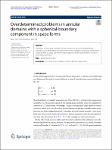Search
Author
- Carlos, Alegría (2)
- Carlos, Seara (2)
- David, Orden (2)
- Klaus, Bretterbauer (2)
- next >
Subject
Date issued
Has File(s)
- true (287)
Search Results
Bringing better spatial experience has been what architects aim to achieve for the past century, while predicting and simulating one’s spatial experience accurately is almost an impossible task for those who don’t have enough experience. Tools and techniques were invented in the progress to support designers to catch what users might really perceive. Diagrams that reflect the interaction between users and space is one of those tools. |
This research shows the light effects and geometric alignments created by the sunlight passing through the stained glasses of the Eastern rose window in Mallorca cathedral and projecting on the inner side of the cathedral’s main façade. Besides, we show other novel effects which occur in coincidence with certain religious festivities. |
This research concerns the development of a parametric format for the semantic description of 3D city models. Following a brief review of the state of the art, the case study is introduced (an historical city block in Catania) whose geometries will be semantically organised through the VPL Grasshopper. |
The aim of this paper is to provide necessary and sufficient conditions on the generator of a multiplication operator acting in the spaces of functions of bounded Young and Riesz variation so that it is, among other things, invertible, continuous, finite rank, compact, Fredholm or has closed range. Furthermore, we characterize various spectra of such operators and give some estimates on their measure of non-compactness. |
We obtain a Serrin-type symmetry of the solutions to various overdetermined boundary value problems in annular domains with a spherical-boundary component in space forms by using the maximum principle for suitable subharmonic functions and integral identities. |
The use of tangible models to enhance spatial skills and geometric thinking is common practice in architects’ and mathematicians’ curricula. Thanks to its design/folding, origami is a powerful tool for transversal didactic experiences between drawing and geometry, where we find the ideal context in which to verify its effectiveness. |
It is shown that the relative distance in Frobenius norm of a real symmetric order-d tensor of rank-two to its best rank-one approximation is upper bounded by 1−(1−1/d)d−1−−−−−−−−−−−−−√. This is achieved by determining the minimal possible ratio between spectral and Frobenius norm for symmetric tensors of border rank two, which equals (1−1/d)(d−1)/2. These bounds are also verified for arbitrary real rank-two tensors by reducing to the symmetric case. |
The Eden cell growth model is a simple discrete stochastic process which produces a “blob” (aggregation of cells) in Rd: start with one cube in the regular grid, and at each time step add a neighboring cube uniformly at random. This process has been used as a model for the growth of aggregations, tumors, and bacterial colonies and the healing of wounds, among other natural processes. Here, we study the topology and local geometry of the resulting structure, establishing asymptotic bounds for Betti numbers. |
An approach to digitally model the decorative elements window’s of architectural heritage—the College of Nobles, Turin—in HBIM, by applying De Luca’s method. The strategy is to transform them into mathematical ratios and parameters in order to create flexible and adaptable models that can generate variations. |
In this work we consider solutions to stochastic partial differential equations with transport noise, which are known to converge, in a suitable scaling limit, to solution of the corresponding deterministic PDE with an additional viscosity term. Large deviations and Gaussian fluctuations underlying such scaling limit are investigated in two cases of interest: stochastic linear transport equations in dimension D≥2 and 2D Euler equations in vorticity form. In both cases, a central limit theorem with strong convergence and explicit rate is established. The proofs rely on nontrivial tools, like the solvability of transport equations with supercritical coefficients and Γ-convergence arguments. |










